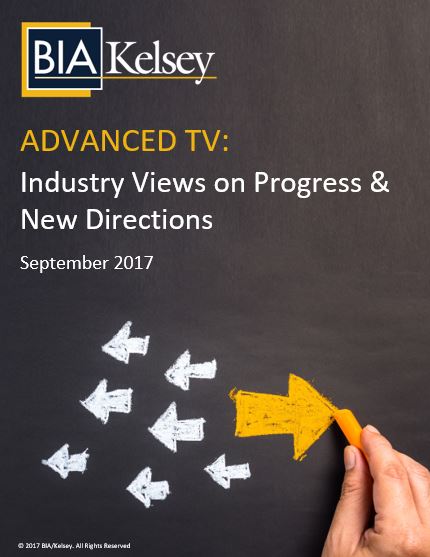
BIA/Kelsey’s latest research report examining Advanced TV shows continuing innovation and progress albeit with hurdles and challenges. BIA/Kelsey defines “advanced TV” as comprising the domains of data-enhanced audience targeting via addressable, contextual audience networks, OTT, Connected TV and programmatic TV platforms. Advanced TV is reshaping norms and expectations primarily in the national but increasingly the local TV market as well. We’re seeing this through developments in technology platforms, data infusion, and new forms of workflow automation and efficiency. The key components of Advanced TV include Platforms, Workflow, and Data. In this report, we share views from top executives at some of the leading companies to get a sense of the progress we’ve made to date and how the new directions are evolving.
Here are some of the highlights we present in this report:
- AudienceExpress finds that Advanced TV is often a “managed service” or largely manual service, even though it benefits from more automated workflows.
- Discovery Engage uses two types of data: Off-the-Shelf and Custom. “With “off the shelf” data, the data segments are readily available and can be created on demand through an advertiser’s preferred Boolean logic. “Custom” data is data ingested from outside sources as requested from advertiser or agency. This class of data consists of first party data or advertiser CRM data segments, digital/DMP segments, mobile ID data (location-based) and or Agency custom proprietary data sets.”
- FreeWheel sees a market where, “Workflow is fragmented across the screens. Steps being taken to make the process more holistic. The silos and technology stacks that exist between linear TV and digital video means that we have some time to go before we can fully operationalize, execute, and optimize single buys across all video environments.”
- Sinclair Broadcast Group argues that, “Local television faces an impediment of being very difficult to buy versus other (often inferior) media options. We need to become easier to buy. Local TV systems and buying protocols were designed for simple local sales around single stations – the ecosystem has evolved far beyond the traditional spot based, single station sales paradigm, as consolidation has spawned larger broadcast groups. Furthermore, the ATSC 3.0 landscape will spur added complexity and opportunity that will need its own automation.”
- TiVo looks to data evolution. “The industry is evolving; from using data sets just for planning to now executing TV campaigns against them to great success. Furthermore, the data is now used more frequently to measure business outcomes from TV campaigns. It’s becoming foundational throughout the end-end workflow of advanced TV, as well as creating a strong connectivity for targeting across screens.”
- Tremor Video [Editor’s Note: Beginning September 26, Tremor will trade under its new name, Telaria] lives in the OTT world. “Compared with traditional, digital video advertising, Over-the-Top (OTT) lacks formalized industry wide standards to support mobile video buying and selling. However, with that said, enhanced targeting is being introduced by progressive DMPs and the adoption by an increasing number of brands, based on the wave of consumption is growing in advance of more formal and traditional measurement.”
To access this premium report, click here.

This Post Has 0 Comments